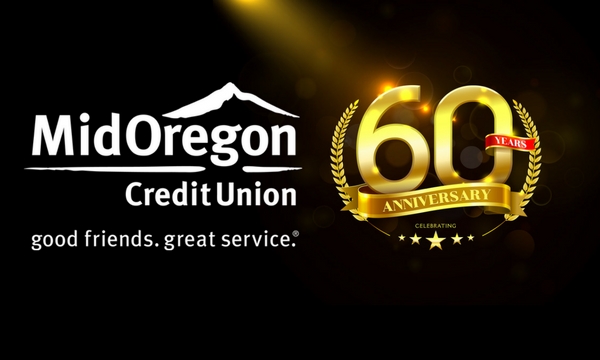The Bottom Line
Small business is important to Central Oregon, and to Mid Oregon. Find tips and resources for business, and information about Mid Oregon’s commercial services and business members.

Mid Oregon Credit Union Turns 60!
Mid Oregon Celebrates Sixty Years in Central Oregon
Mid Oregon Credit Union turns 60! Eight educational visionaries in Prineviille signed our Organization Certificate on November 8th, 1957. That day the credit union had $40 in assets, eight members and zero employees. Two weeks later the certificate was approved by the Bureau of Federal Credit Unions, and the rest is history. Mid Oregon President & CEO Bill Anderson recently said this about why those members started their own financial cooperative:
“…if they don’t have one that’s serving their needs, they have the right to start their own. That’s how our cooperative was founded back in 1957, when eight Prineville educators pooled their savings to give each other loans in times of need.”
From the original credit union “office” in a home in Prineville, we have grown to seven offices across Central Oregon, and are headquartered in Bend. Mid Oregon continues to expand and provide exceptional service, growing to assets worth over $270 million, while developing new and innovative product offerings that provides our members with financial tools necessary for their success.
From Educators to Central Oregon
Originally chartered in 1957 as “Tri-County Teachers Federal Credit Union”, the first field of membership included “Employees of the Public Schools who work in Crook, Deschutes and Jefferson Counties, Oregon; Employees of this credit union; members of their immediate families; and organizations of such persons.” Today, as Mid Oregon Credit Union, our field of membership includes more Central Oregon residents, but serves the same purpose. Anderson said it well at the time of our 50th Anniversary in 2007:
“Mid Oregon was formed as a cooperative in 1957 to provide financial services for teachers who were underserved by mainstream financial institutions. As a result of a few teachers who banded together to help each other, today the Credit Union is available for all those who live, work, worship or go to school in Deschutes, Jefferson, Crook, (Today also including Wheeler, Lake and North Klamath counties). The vision and spirit of that small group is still alive today.”
Thanks for Making our 60th Year the Best Yet.
We would like to thank those who have worked this year to make 2017 a banner year for Mid Oregon. We would also invite them, and you, to celebrate with us. Stop by one of our branches in Bend, Redmond, Prineville, Madras, La Pine & Sisters, or connect with us digitally through email or through our Facebook or LinkedIn pages, to wish the credit union a Happy Anniversary!
Our gratitude goes out to…
- Mid Oregon Credit Union’s 29,000 members.
- Our 100+ employees
- Our region’s auto and RV dealers
- The Chambers of Commerce in Central Oregon
- Our media partners
- Rotary, Kiwanis and other service organizations
- The local vendors and organizations that keep us going
- Our financial services partners Arbor Mortgage Group, Mid Oregon Wealth Management and Cascade Insurance Center
- EDCO, REDI, COVA and all who drive Central Oregon economic growth
- Bend Garbage & Recycling for their help with Free Shred Day and Supplies 4 Schools
- All of Central Oregon public schools, educators, foundations and supporters
- Those who govern and administer the municipalities where we live and work
- COCC and OSU Cascades
- Our community partners, including FAN, High Desert Museum, Better Together, Junior Achievement, Boys & Girls Clubs, Healthy Beginnings, COVO, Red Cross, Crook County Foundation and too many more to list
- Our employer partners who entrust us with improving the financial wellbeing of their employees
- Central Oregon Chapter of Credit Unions, and our regional and national associations
- and many, many more!

You’ve just discovered fraud. Now what?
As hard as we try to keep ourselves safe, identity fraud is likely to happen to most of us sooner or later. Don’t panic. Here are some steps to take, and some resources that can help.
You open your credit card statement, and you see a charge you didn’t make. You apply for a loan, and you notice an account you didn’t open. Oh, no!
For most consumers, this is one of their worst nightmares come true. But just as with disaster or fire preparedness, knowing what to do when we’re a victim of identity fraud is something that we all need to know.
And just as with a natural disaster or a house fire, the first thing we need to remember is: Don’t panic. Take a deep breath and remember your plan. Wait, do you have a plan?
You’re not on your own
Years ago, consumers were largely on their own when they discovered fraud on their accounts. Recovery was painful and laborious, and it was easy to forget crucial steps. Today, although identity theft is still an unexpected pain none of us wants to experience, we have more tools and resources we can use to make recovery go faster.
Identitytheft.gov—learn the steps, create a plan
One of the best links you can keep handy is identitytheft.gov. This site was created by the federal government to help consumers just like you when the worst happens. Go straight to the home page and get started when you suspect some fraud has occurred on your accounts. The site will help you develop a plan and give you simple, basic steps you can put into action immediately, in the order of importance, so you don’t get flustered and thrown off-track.
Or, if you want to review them now, just click browse recovery steps to review what you should do if this ever happens to you. You can even print the handy checklists so you can keep them handy at home or at your office. You can even pull up steps to take for special forms of identity theft, such as tax identity theft or identity theft for minors or medical accounts.
Use our tools—CardNav and Verified by VISA
Don’t forget that there are also steps you can take to help you reduce the possibility and severity of any fraud that might occur on your account. CardNav is an easy app you can install on your iOS or Anroid mobile device to turn your debit cards on or off if they’re ever lost or stolen. You can also limit locations where the card may be used, set thresholds for transaction amounts, and specify the types of transactions permitted. With Verified by VISA, you can register a password on your VISA card to ensure that you’re the only one using it for online purchases. It’s free and easy to set up!
No one wants to be a victim of identity theft. But if you do, don’t be caught unprepared. Review the steps and get your plan in place now! And if you ever experience fraud on any of your Mid Oregon accounts, contact us right away so we can help. too.
Related articles
Do you want to learn more about keeping your accounts safer from identity fraud? Check out these related resources and articles for more tips and suggestions:
- Stickley On Security (on the Mid Oregon site)
- 10 places NOT to use your debit card (from CreditCards.com)
- Credit card vs. debit card: Which is safer online? (from Nerdwallet)

What Does “Local” Really Mean?
What Does “Local” Really Mean?
You’ve heard the message a lot in the media lately: Financial institutions in our area claiming to be “local.” Sure, for many consumers who are new to Central Oregon from another region or state, a financial institution that’s headquartered in Portland or Billings might feel local. But what does local really mean to you?
We have seen a lot of change–and a little bit of confusion–occurring in our local financial landscape over the past year or so. Some institutions have merged with larger, regional institutions; some have been caught doing things that aren’t exactly in their customers’ best interests; and quite a few have implemented changes that could be costing you more money to manage your financial lives—such as eliminating free checking.
Central Oregon Financial Choices
The good news is that consumers in Central Oregon have a lot of choices, thanks in part to the credit union movement. For decades, we’ve worked to protect your right to choose your financial institution. As a result, we find that communities with a credit union presence pay lower interest rates on loans, and pay fewer fees, than communities whose consumers lack those options. Even if they’re not credit union members!
And if they don’t have one that’s serving their needs, they have the right to start their own. That’s how our cooperative was founded back in 1957, when eight Prineville educators pooled their savings to give each other loans in times of need.
Local: Headquartered In and Serving Central Oregon
So, if you’re choosing a financial institution that’s headquartered, founded, and exclusively serving the folks of Central Oregon, there’s only one—Mid Oregon Credit Union. We were founded here, we’re staying here, and we have only one purpose—to meet your financial needs and help you achieve your dreams. To us, being local means we make sure that you get the financial services you need more conveniently and affordably, and we do our part to support the community that we all call home.
Thanks for your membership. We look forward to seeing you soon.
